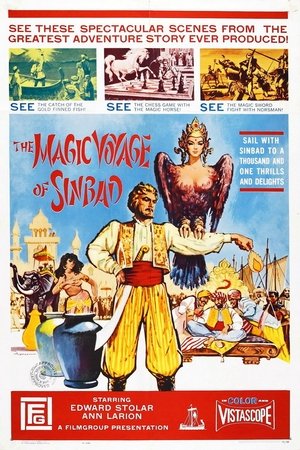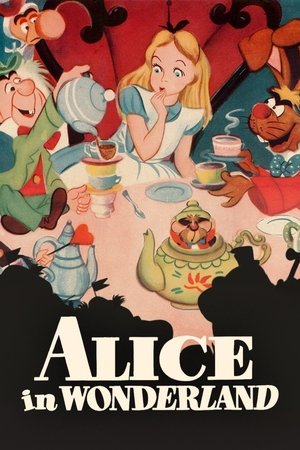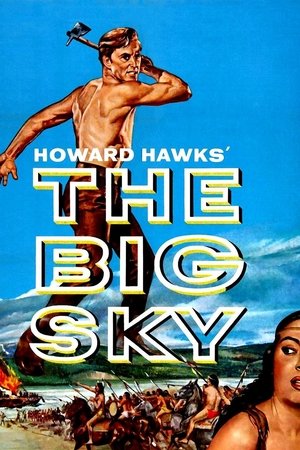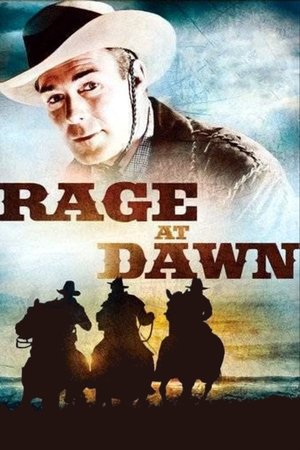The Magic Voyage of Sinbad (1953)

| Director | Aleksandr Ptushko |
| Cast | Alla Larionova, B. Surovtsev, Ivan Pereverzev, Lev Fenin, Lidiya Vertinskaya |
| Year | 1953 |
| Country | N/A |
| Genres | Action, Adventure, Family, Fantasy |
| Duration | 80 min |
| Release | 05 Jan 1953 |
| Language | Pусский |
| Revenue | N/A |
| Trailer | Watch Trailer |
Synopsis
Sadko is based on an opera by Nikolai Rimsky-Korsakov, which was based on a Russian epic tale of the same name. In the old Russian city of Novgorod, the merchants are feasting in a gorgeous palace and Sadko is bragging that he can bring to their land a sweet-voiced bird of happiness. They laugh at him, but he is offered help by the Ocean King’s daughter, who is mesmerized by Sadko’s singing and is in love with him. The hero is destined to visit many lands in his search of the bird. First shown in the USA in 1953 with English subtitles. This entry is for 1962 English-dub by Roger Corman’s Filmgroup, which runs about 8 minutes shorter (removes much of the music) than the Russian original (see, Sadko, 1953)
Sadko, a film based on the opera by Nikolai Rimsky-Korsakov, finds its roots in a Russian epic tale that captures the imagination with its rich narrative and vibrant storytelling. Set in the ancient Russian city of Novgorod, the story unfolds in a grand palace where merchants indulge in a lavish feast. Amidst the celebration, Sadko, the protagonist, boasts of his ability to bring back a mythical bird of happiness to their land. Skepticism abounds as the merchants laugh off his claims, yet fate has other plans for Sadko.
The tale takes a magical turn when the Ocean King’s daughter, captivated by Sadko’s enchanting voice and her burgeoning love for him, offers her assistance. This divine intervention sets Sadko on an adventurous quest across various lands in search of the elusive bird. The journey is nothing short of a magical voyage, taking audiences through a spectrum of landscapes and encounters that are both enchanting and perilous.
Released in the United States for the first time in 1953 with English subtitles, this cinematic gem was later reintroduced in 1962 through an English-dubbed version by Roger Corman’s Filmgroup. This version, while slightly shorter by about eight minutes due to the reduction of musical sequences, retains the core essence of the Russian original. The film, also known as “The Magic Voyage of Sinbad,” can be explored further at The Magic Voyage of Sinbad (1953) where viewers can delve into the film’s intriguing details and historical context.
The film’s cast, though not widely known outside Russia, delivers performances that bring to life the rich tapestry of emotions and cultural nuances embedded in the story. Directed with a keen eye for visual splendour and narrative depth, Sadko offers a glimpse into the world of Russian folklore through a cinematic lens. The genre, a blend of fantasy and adventure, allows for a creative exploration of mythical themes that resonate with audiences across different cultures.
One of the highlights of Sadko is its ability to weave music into the narrative, a nod to its operatic origins. Although the English-dubbed version reduces the musical elements, the film’s score remains an integral part of its charm. The music not only enhances the storytelling but also pays homage to the rich tradition of Russian operatic compositions.
The film maintains a respectable rating on IMDb, reflecting its enduring appeal and the fondness with which it is remembered by audiences. The rating serves as a testament to the film’s ability to transcend cultural boundaries and its timeless appeal as a piece of cinematic art.
As Sadko embarks on his quest, he encounters a myriad of characters and situations that test his resolve and courage. Each land he visits presents new challenges and lessons, ultimately shaping him into a hero worthy of his quest. The journey is a metaphor for personal growth and the pursuit of happiness, themes that are universally relatable.
The Ocean King’s daughter, a pivotal character in Sadko’s journey, embodies the mystical allure of the sea and the unknown. Her character adds a layer of romance and intrigue to the narrative, further enriching the tapestry of the story. Her love for Sadko is both a driving force and a source of conflict, reflecting the complex interplay of human emotions and divine intervention.
In essence, Sadko is not just a film but a cultural artefact that offers a window into Russian folklore and the timelessness of epic tales. It stands as a testament to the power of storytelling and the universal quest for happiness and fulfilment. For those intrigued by the allure of classic cinema and the magic of epic narratives, Sadko promises an unforgettable journey that transcends time and place.
















